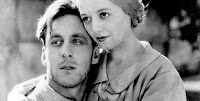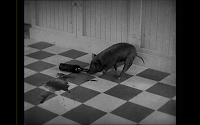 |
| Charles King and his lovely girls! |
Several studios had been trying out bits of sound in movies by using musical performances for several years (technically, that's really all that The Jazz Singer did!) and by 1929 they were filming longer and longer musical sequences. However, The Broadway Melody was the first of these films to have sound throughout and also have a fully realised plot.
It made an absolute fortune at the box office and was easily the biggest hit of the year. People hadn't seen (or heard) anything quite like it before and they loved it! The technology, artistry and imagination behind MGM musicals, along with those of other studios, started here and then went into overdrive - meaning that The Broadway Melody was already looking dated by the time its sequel was released six years later.
It is now one of the lowest rated Best Picture winners on IMDB. We were very curious to find out whether it really deserves its 6.3!
The Ceremony:
 |
| A slightly more formal ceremony than the first one |
The Awards took place on 3rd April 1930 at the Cocoanut Grove in the Ambassador Hotel. It was the first ceremony to be broadcast (on radio) and also the first where the winners didn't know until the night if they had won.
It had a slightly higher profile than the first Awards, but fewer Oscars were given out - only seven, each of which went to a different film.
This ceremony took place a long time after the movie season it was honouring - and so it was agreed that the next ceremony would be moved forward to November, meaning that there were two ceremonies within one year (although the next one was honouring a whole different one year period!)
Other Notable Winners That Night:
Best Director went to British Director Frank Lloyd (who would win again in a few years). He was nominated for three different films but won for The Divine Lady, a film about Lady Hamilton.
Best Actor was Warner Baxter and Best Actress was the legendary Mary Pickford, one of few silent film megastars that was critically acclaimed for any talking roles!
What We Could/Should Have Been Watching:
The Broadway Melody wasn't the only MGM Musical vehicle to be nominated this year - the other was Hollywood Revue, now most famous for introducing the song "Singin in the Rain". It had a few technicolor sequences going for it, and also featured Bessie Love and Anita Page (and Joan Crawford, among others) but it was just a variety show with no plot so was always going to lose out to MGM's other nominee!
The other nominees were crime drama Alibi, western In Old Arizona (for which Warner Baxter won his Oscar) and historical drama The Patriot (now lost).
The technical achievements and box office success of The Broadway Melody probably justify it winning against these particular films, for all its faults!
Our Verdict:
This was always going to be my sort of film far more than Andy's. I love Hollywood Musicals. I've got shelves of them and could go on about them at great length given half a chance. I already knew quite a lot about this film and had seen some of the musical numbers before, but never the whole thing.
I'm very glad to have finally watched it, and I enjoyed it. But it's not a good film. Not by MGM's standards even half a dozen years later. Andy drifted off and picked up his laptop within about 15 minutes, leaving the film in the background. It kept my interest a little more, but mainly because I had a lot to critically compare it to.
 |
| The Mahoney Sisters show what they can do. (Unfortunately, it's not much!) |
Some people who are very dismissive of the film talk about the clunky editing, the static dance numbers, the long gaps without dialogue or background noise etc. I didn't mind any of that - those things were of their time, they were still experimenting with sound and music. Put those in their historical context and they are impressive. For example, the opening scene at (what I presume is) a Tin Pan Alley office is, by modern standards, an absolute mess with so many different people talking and singing and strumming all at the same time. By 1929 standards it's a technical triumph!
 |
| These two were both big MGM stars. Unfortunately only one of them could act! |
The bigger problem, in my view, is that the script isn't anywhere near as good as it could have been and the acting and performing is very ropey in parts. They'd been putting plays on Broadway for years before they could film any of them - I would have thought they could have got this part right!
The two female leads were plucked from the MGM books and had both previously been picked as "Baby Stars" of the 20s. Bessie Love is by far the best thing in the film. She's not the greatest singer in the world, but she's got great comedic timing and a lot of sass and warmth. I really liked her throughout the whole film. Anita Page however seems to have got by in silent films on her looks, and hadn't quite worked out how to do anything much else. Giving her an all talking all singing part probably wasn't the best move.
The characters were also meant to be this great act that wowed people all over America and were destined to be Broadway stars. So you'd think the actors playing them would be able to perform brilliantly as a duo. But they don't.
 |
| Making the most of the last few years before the Hays Code kicks in! |
The big musical numbers are really what it's all about. They are actually pretty good - there just aren't enough of them.
 |
| Probably the most successful musical number in the film! |
Other than that, we get a well-staged version of the title track - including an extraordinary tap solo in ballet shoes en point! (She turns up about 1 minute into this clip.)
 |
| The most talked about musical number in the film - the priest has just back flipped his way down the aisle! |
So - all in all, it was an interesting film, a thing of its time, worth watching for a musicals fan like me. But a bit of a slog in parts and really not as good as I thought it would be.
The Broadway Melody may not have exactly stood the test of time, but it provided a template for lots of similar - and much much better - musical films in over the next few decades. It's a shame really that it was this one that won the Oscar, rather than 42nd Street a few years later - a film that presents pretty much the same idea but with far greater success! It's also one of the films that inspired arguably the greatest movie musical of all, the shockingly un-nominated Singing in the Rain. Several of the songs from The Broadway Melody are on its soundtrack. And, of course, there were three more Broadway Melody films. The last is Broadway Melody of 1940 and it contains quite possibly the best three minutes of anything ever put on film ever. And however clunky the 1929 version was, if it led to this it deserves every award going. Click and enjoy!


















